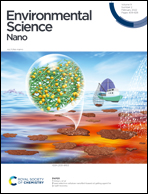Porous organic nanofiber polymers as superfast adsorbents for capturing pharmaceutical contaminants from water†
Abstract
The development of simple, low-cost adsorbents is critical for waste management in the medical industry (in particular, pharmaceutical and personal care product (PPCP) waste) to restore the natural state of the water system. This study presents novel hypercrosslinked hydroxyl-rich porous organic polymers (HPOPs) that were synthesized via Friedel–Crafts reactions as potential adsorbents for PPCP capture. Their successful syntheses, surface properties, and chemical stabilities were investigated through various characterization tools. The uniquely structured HPOP-3, denoted as porous organic nanofiber (PONF), shows superior adsorption capacities for three model PPCPs (diclofenac sodium, sulfamethoxazole, and acetaminophen) compared to most of the other reported benchmark materials. Furthermore, due to its unique surface properties such as well-defined hierarchical porosity containing both micropores and mesopores and nanofiber-like structure, PONF exhibits superfast adsorption kinetics for all the model PPCPs. It also shows excellent selectivity against another large organic compound (humic acid) and metal ions (Na+, K+, Ca+, and Mg2+), which are commonly contained in wastewater. PONF shows decent reusability over 10 cycles without a deterioration in the sorption capacity. A plausible host–guest mechanism for superior PPCP adsorption on PONF is also proposed.



 Please wait while we load your content...
Please wait while we load your content...